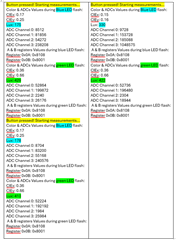Tool/software:
Dear Daniel,
I decided to use the component in an application where I send a flash of light on a colored sheet and I would like to measure the color and the lux level. It will have to be fast.
I think to use the INT pin and configure it as a trigger for the conversion. What are the steps in order to speed up the conversion? I will use a conversion time of 600us per channel
. Could you give me your opinion and how to do it so as not to waste time in the conversion. I fear that writing to the register will slow me down. Can you give me the sequence to
do in order? Example? First define the INT pin as input, then write to the 0x0B register to switch to one shot, ... etc. Thank you in advance for your help and advice.
Toufik.




